2019 TOYOTA SUPRA airbag
[x] Cancel search: airbagPage 8 of 456
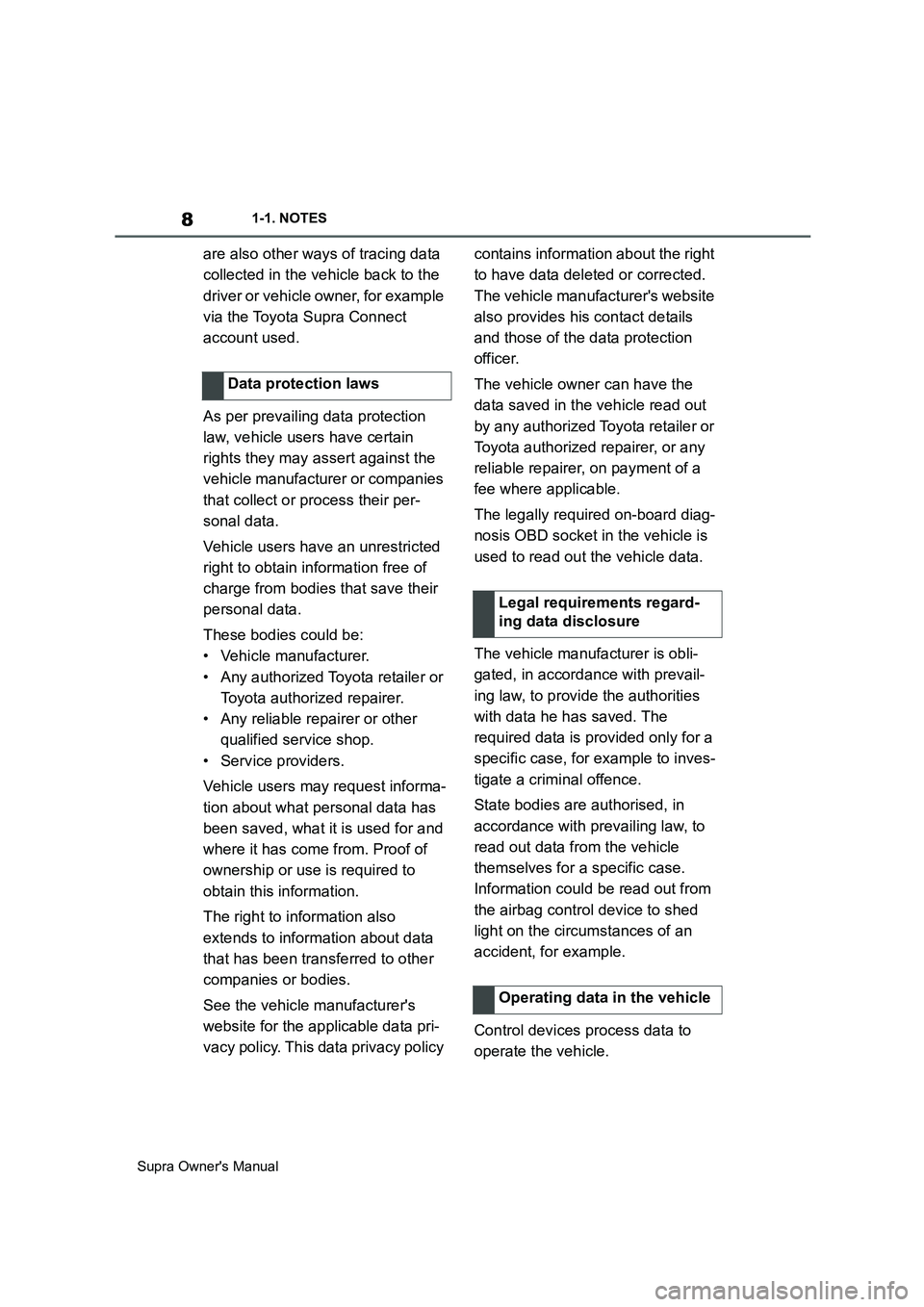
8
Supra Owner's Manual1-1. NOTES
are also other ways of tracing data
collected in the vehicle back to the
driver or vehicle owner, for example
via the Toyota Supra Connect
account used.
As per prevailing data protection
law, vehicle users have certain
rights they may assert against the
vehicle manufacturer or companies
that collect or process their per-
sonal data.
Vehicle users have an unrestricted
right to obtain information free of
charge from bodies that save their
personal data.
These bodies could be:
• Vehicle manufacturer.
• Any authorized Toyota retailer or
Toyota authorized repairer.
• Any reliable repairer or other
qualified service shop.
• Service providers.
Vehicle users may request informa-
tion about what personal data has
been saved, what it is used for and
where it has come from. Proof of
ownership or use is required to
obtain this information.
The right to information also
extends to information about data
that has been transferred to other
companies or bodies.
See the vehicle manufacturer's
website for the applicable data pri-
vacy policy. This data privacy policy contains information about the right
to have data deleted or corrected.
The vehicle manufacturer's website
also provides his contact details
and those of the data protection
officer.
The vehicle owner can have the
data saved in the vehicle read out
by any authorized Toyota retailer or
Toyota authorized repairer, or any
reliable repairer, on payment of a
fee where applicable.
The legally required on-board diag-
nosis OBD socket in the vehicle is
used to read out the vehicle data.
The vehicle manufacturer is obli-
gated, in accordance with prevail-
ing law, to provide the authorities
with data he has saved. The
required data is provided only for a
specific case, for example to inves-
tigate a criminal offence.
State bodies are authorised, in
accordance with prevailing law, to
read out data from the vehicle
themselves for a specific case.
Information could be read out from
the airbag control device to shed
light on the circumstances of an
accident, for example.
Control devices process data to
operate the vehicle. Data protection laws
Legal requirements regard-
ing data disclosure
Operating data in the vehicle
Page 9 of 456

9
1
Supra Owner's Manual1-1. NOTES
NOTES
This data includes, for example:
• Status messages of the vehicle
and its individual components,
for example wheel rotation
speed, wheel speed, decelera-
tion, lateral acceleration, fas-
tened seat belt indicator.
• Ambient conditions, for example
temperature, rain sensor signals.
The data is only processed within
the vehicle itself and is usually tran-
sient. The data is not saved after
the vehicle is switched off.
Electronic parts, for example con-
trol devices and vehicle keys, con-
tain components for saving
technical information. Information
on vehicle condition, component
load, maintenance requirements,
events or errors can be saved tem-
porarily or permanently.
This information generally docu-
ments the condition of a compo-
nent, a module, a system or its
environment, for example:
• Operating states of system com-
ponents, for example, fill levels,
tyre inflation pressure, battery
status.
• Malfunctions and faults of impor-
tant system components, for
example, lights and brakes.
• Responses of the vehicle to par-
ticular driving situations, for
example triggering of an airbag,
activation of the drive stability
control systems.
• Information on vehicle-damag-ing events.
The data is required so that the
control units can perform their func-
tions. It is also used for detecting
and rectifying malfunctions, and
helps the vehicle manufacturer to
optimise vehicle functions.
The majority of this data is transient
and is only processed within the
vehicle itself. Only a small propor-
tion of the data is stored in event or
error memories in response to spe-
cific circumstances.
When service work is being carried
out, for example repairs, service
operations, warranty work and
quality assurance measures, this
technical information can be read
out from the vehicle together with
the vehicle identification number.
Any authorized Toyota retailer or
Toyota authorized repairer, or any
reliable repairer can read out the
information. The legally required
on-board diagnostics (OBD) socket
in the vehicle is used to read out
the data.
The data is collected, processed
and used by the relevant organisa-
tions in the service network. The
data documents the technical con-
ditions of the vehicle and helps in
locating errors, complying with war-
ranty obligations and improving
quality.
Furthermore, the manufacturer has
product monitoring obligations to
meet in line with product liability
Page 43 of 456
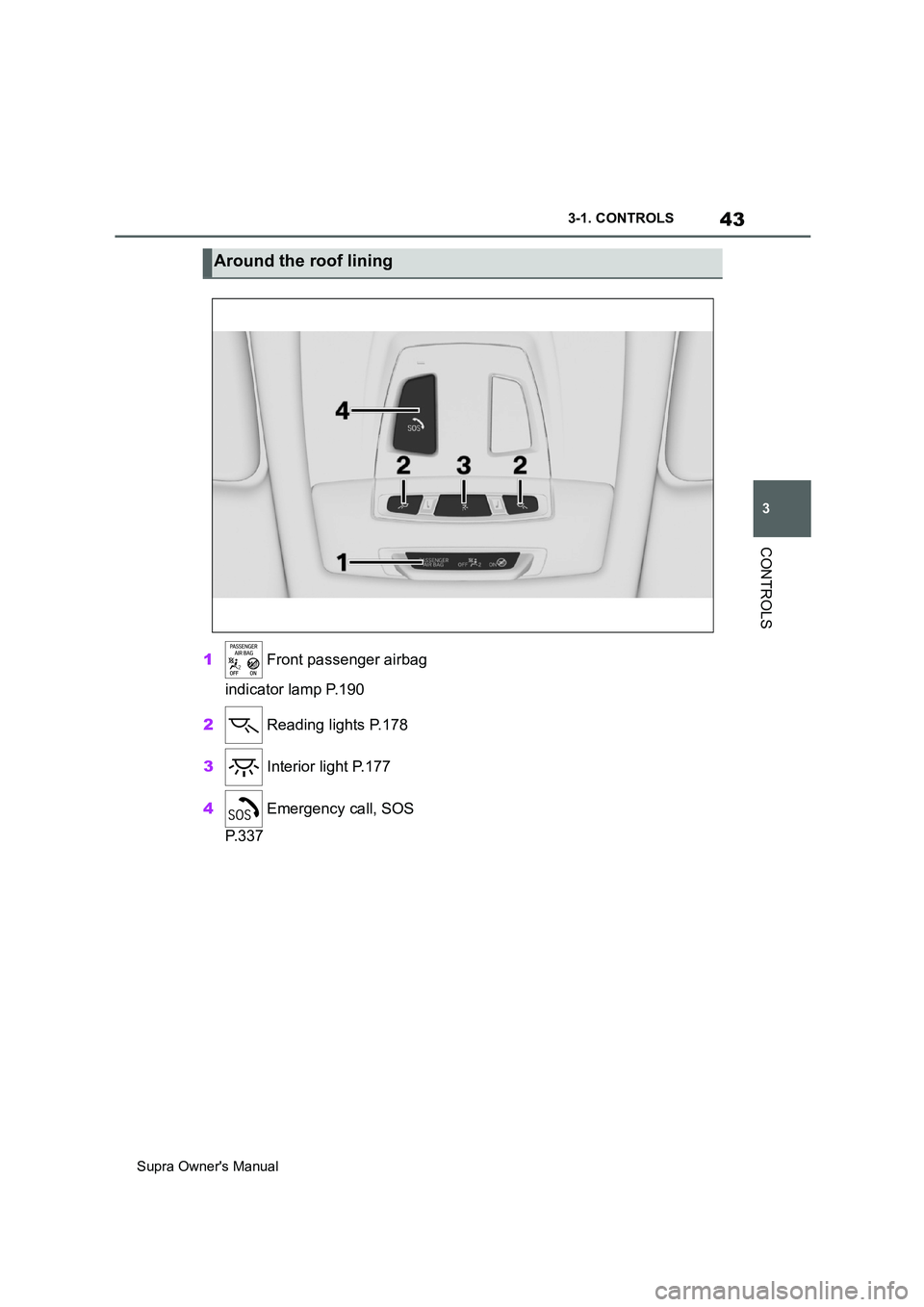
43
3
Supra Owner's Manual3-1. CONTROLS
CONTROLS
1 Front passenger airbag
indicator lamp P.190
2 Reading lights P.178
3 Interior light P.177
4 Emergency call, SOS
P. 3 3 7
Around the roof lining
Page 80 of 456
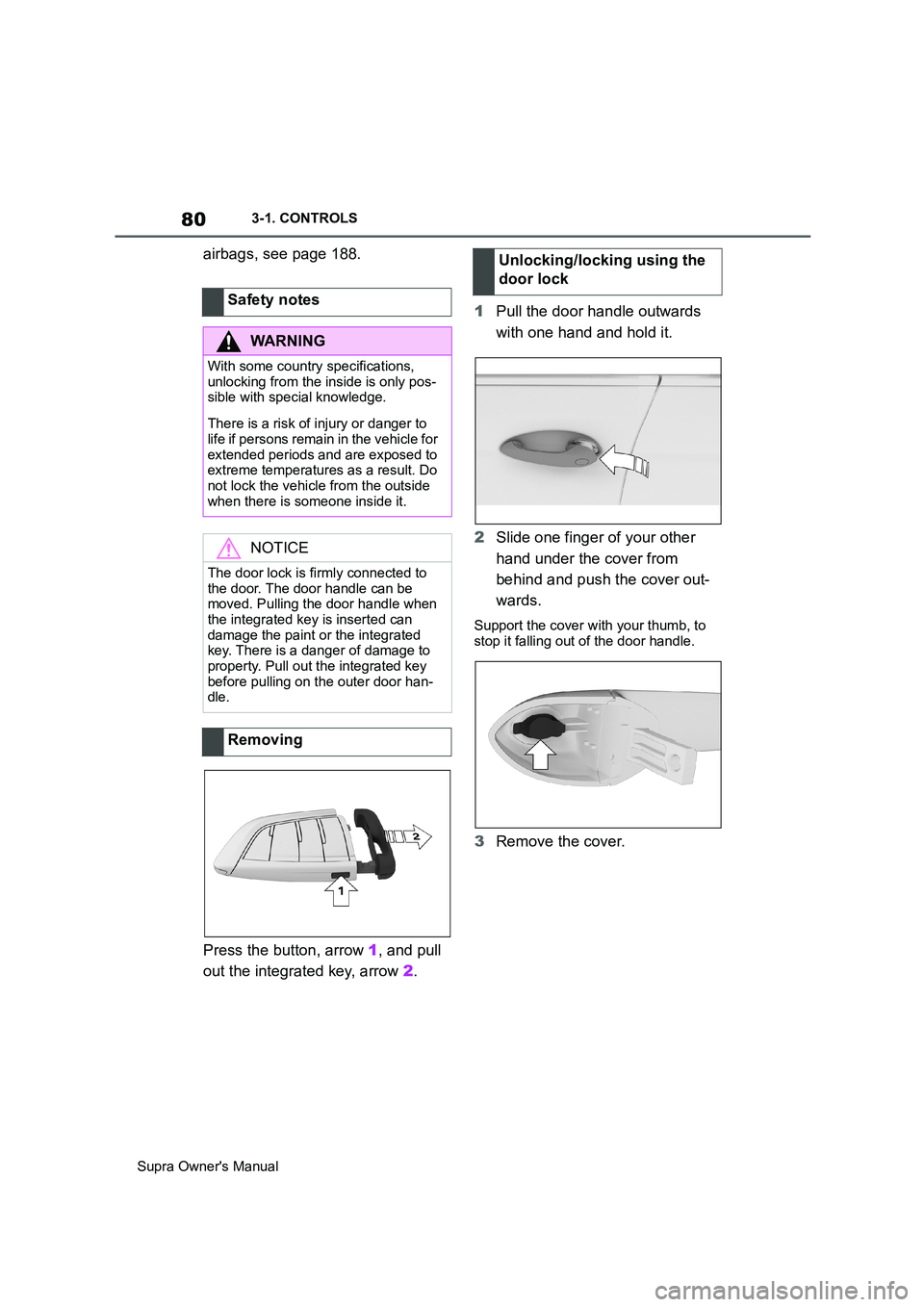
80
Supra Owner's Manual3-1. CONTROLS
airbags, see page 188.
Press the button, arrow 1, and pull
out the integrated key, arrow 2.1Pull the door handle outwards
with one hand and hold it.
2Slide one finger of your other
hand under the cover from
behind and push the cover out-
wards.
Support the cover with your thumb, to
stop it falling out of the door handle.
3Remove the cover. Safety notes
WARNING
With some country specifications,
unlocking from the inside is only pos-
sible with special knowledge.
There is a risk of injury or danger to
life if persons remain in the vehicle for
extended periods and are exposed to
extreme temperatures as a result. Do
not lock the vehicle from the outside
when there is someone inside it.
NOTICE
The door lock is firmly connected to
the door. The door handle can be
moved. Pulling the door handle when
the integrated key is inserted can
damage the paint or the integrated
key. There is a danger of damage to
property. Pull out the integrated key
before pulling on the outer door han-
dle.
Removing
Unlocking/locking using the
door lock
Page 95 of 456
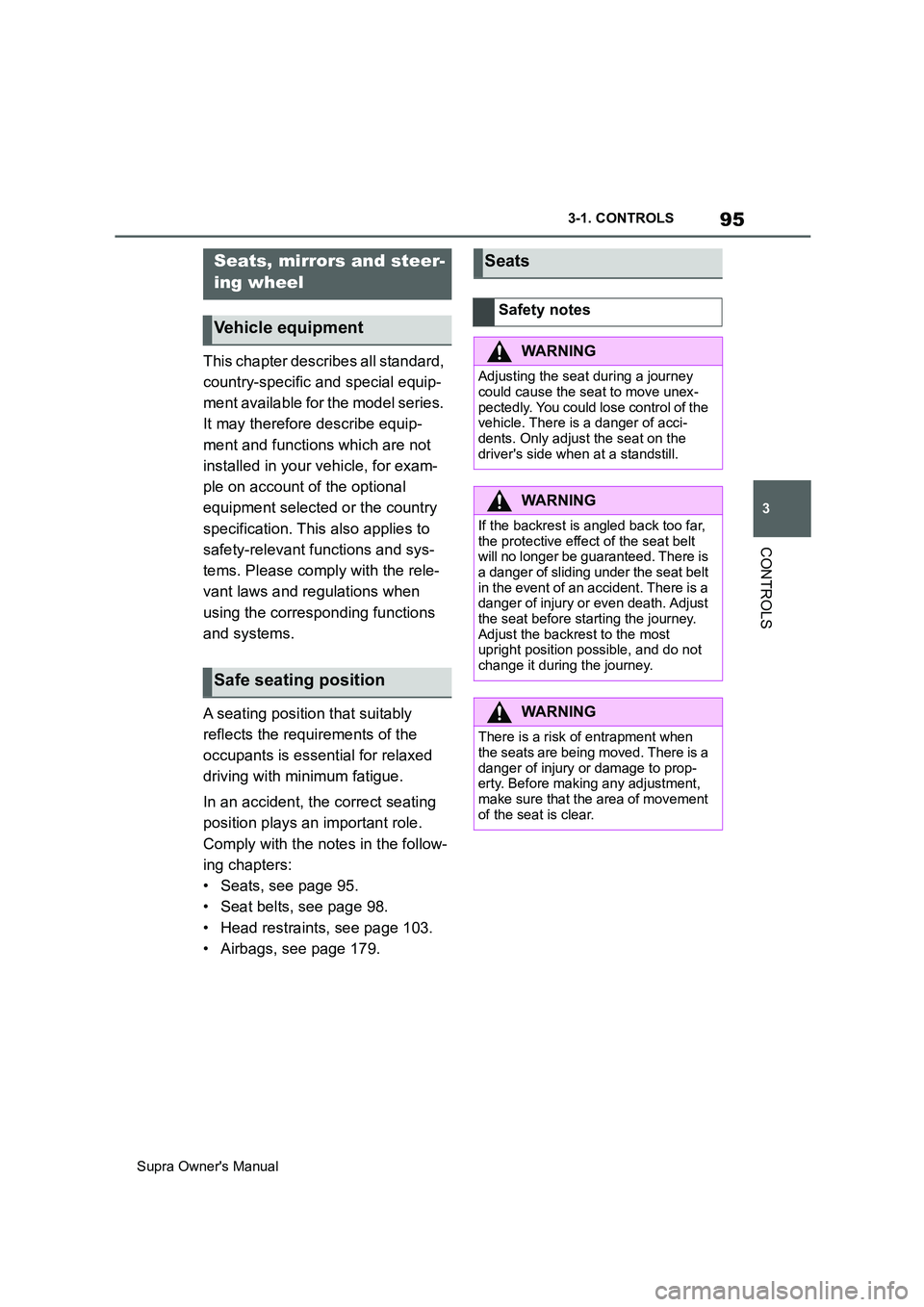
95
3
Supra Owner's Manual3-1. CONTROLS
CONTROLS
This chapter describes all standard,
country-specific and special equip-
ment available for the model series.
It may therefore describe equip-
ment and functions which are not
installed in your vehicle, for exam-
ple on account of the optional
equipment selected or the country
specification. This also applies to
safety-relevant functions and sys-
tems. Please comply with the rele-
vant laws and regulations when
using the corresponding functions
and systems.
A seating position that suitably
reflects the requirements of the
occupants is essential for relaxed
driving with minimum fatigue.
In an accident, the correct seating
position plays an important role.
Comply with the notes in the follow-
ing chapters:
• Seats, see page 95.
• Seat belts, see page 98.
• Head restraints, see page 103.
• Airbags, see page 179.
Seats, mirrors and steer-
ing wheel
Vehicle equipment
Safe seating position
Seats
Safety notes
WARNING
Adjusting the seat during a journey
could cause the seat to move unex-
pectedly. You could lose control of the
vehicle. There is a danger of acci-
dents. Only adjust the seat on the
driver's side when at a standstill.
WARNING
If the backrest is angled back too far,
the protective effect of the seat belt
will no longer be guaranteed. There is
a danger of sliding under the seat belt
in the event of an accident. There is a
danger of injury or even death. Adjust
the seat before starting the journey.
Adjust the backrest to the most
upright position possible, and do not
change it during the journey.
WARNING
There is a risk of entrapment when
the seats are being moved. There is a
danger of injury or damage to prop-
erty. Before making any adjustment,
make sure that the area of movement
of the seat is clear.
Page 99 of 456
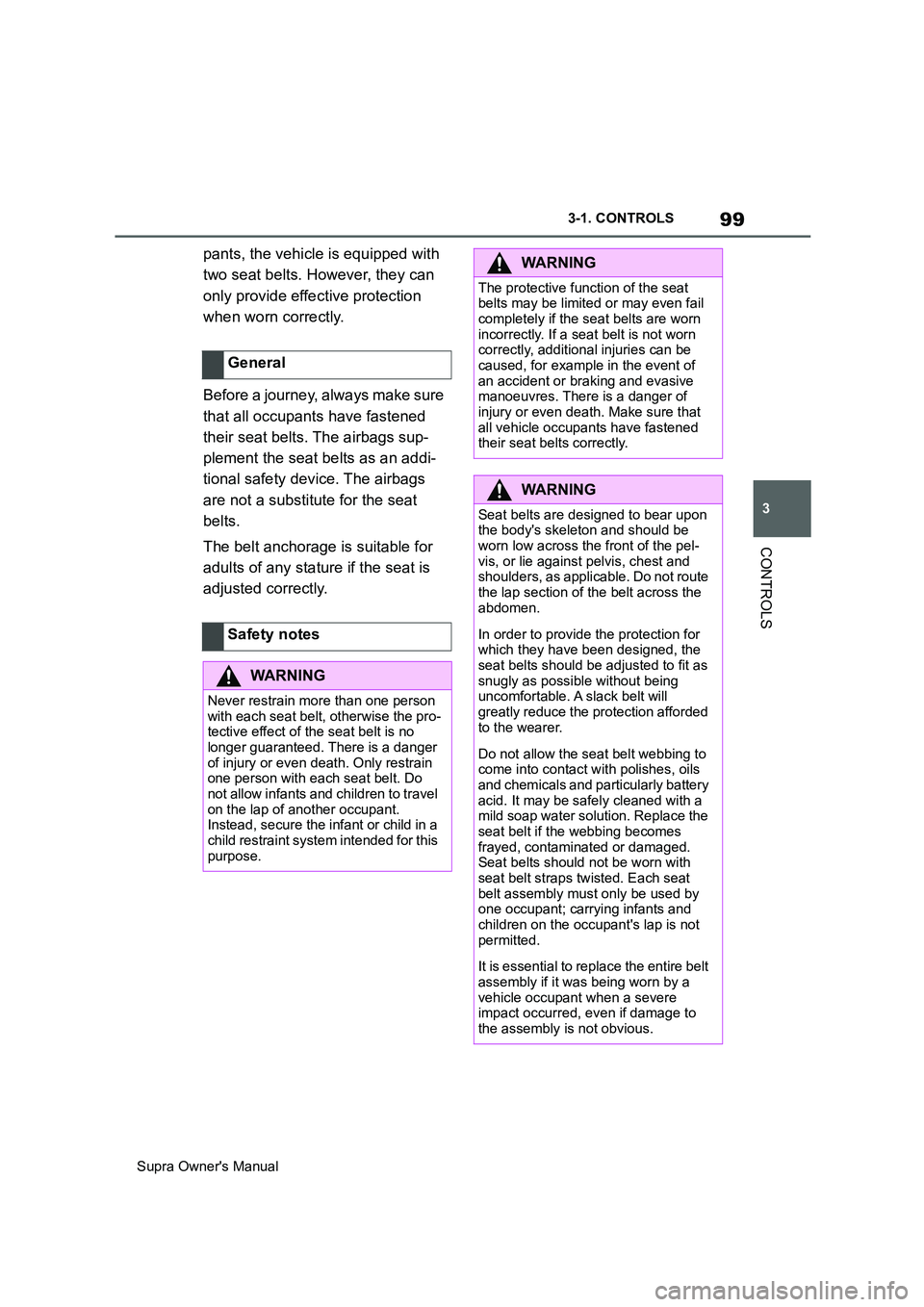
99
3
Supra Owner's Manual3-1. CONTROLS
CONTROLS
pants, the vehicle is equipped with
two seat belts. However, they can
only provide effective protection
when worn correctly.
Before a journey, always make sure
that all occupants have fastened
their seat belts. The airbags sup-
plement the seat belts as an addi-
tional safety device. The airbags
are not a substitute for the seat
belts.
The belt anchorage is suitable for
adults of any stature if the seat is
adjusted correctly.General
Safety notes
WARNING
Never restrain more than one person
with each seat belt, otherwise the pro-
tective effect of the seat belt is no
longer guaranteed. There is a danger
of injury or even death. Only restrain
one person with each seat belt. Do
not allow infants and children to travel
on the lap of another occupant.
Instead, secure the infant or child in a
child restraint system intended for this
purpose.
WARNING
The protective function of the seat
belts may be limited or may even fail
completely if the seat belts are worn
incorrectly. If a seat belt is not worn
correctly, additional injuries can be
caused, for example in the event of
an accident or braking and evasive
manoeuvres. There is a danger of
injury or even death. Make sure that
all vehicle occupants have fastened
their seat belts correctly.
WARNING
Seat belts are designed to bear upon
the body's skeleton and should be
worn low across the front of the pel-
vis, or lie against pelvis, chest and
shoulders, as applicable. Do not route
the lap section of the belt across the
abdomen.
In order to provide the protection for
which they have been designed, the
seat belts should be adjusted to fit as
snugly as possible without being
uncomfortable. A slack belt will
greatly reduce the protection afforded
to the wearer.
Do not allow the seat belt webbing to
come into contact with polishes, oils
and chemicals and particularly battery
acid. It may be safely cleaned with a
mild soap water solution. Replace the
seat belt if the webbing becomes
frayed, contaminated or damaged.
Seat belts should not be worn with
seat belt straps twisted. Each seat
belt assembly must only be used by
one occupant; carrying infants and
children on the occupant's lap is not
permitted.
It is essential to replace the entire belt
assembly if it was being worn by a
vehicle occupant when a severe
impact occurred, even if damage to
the assembly is not obvious.
Page 100 of 456
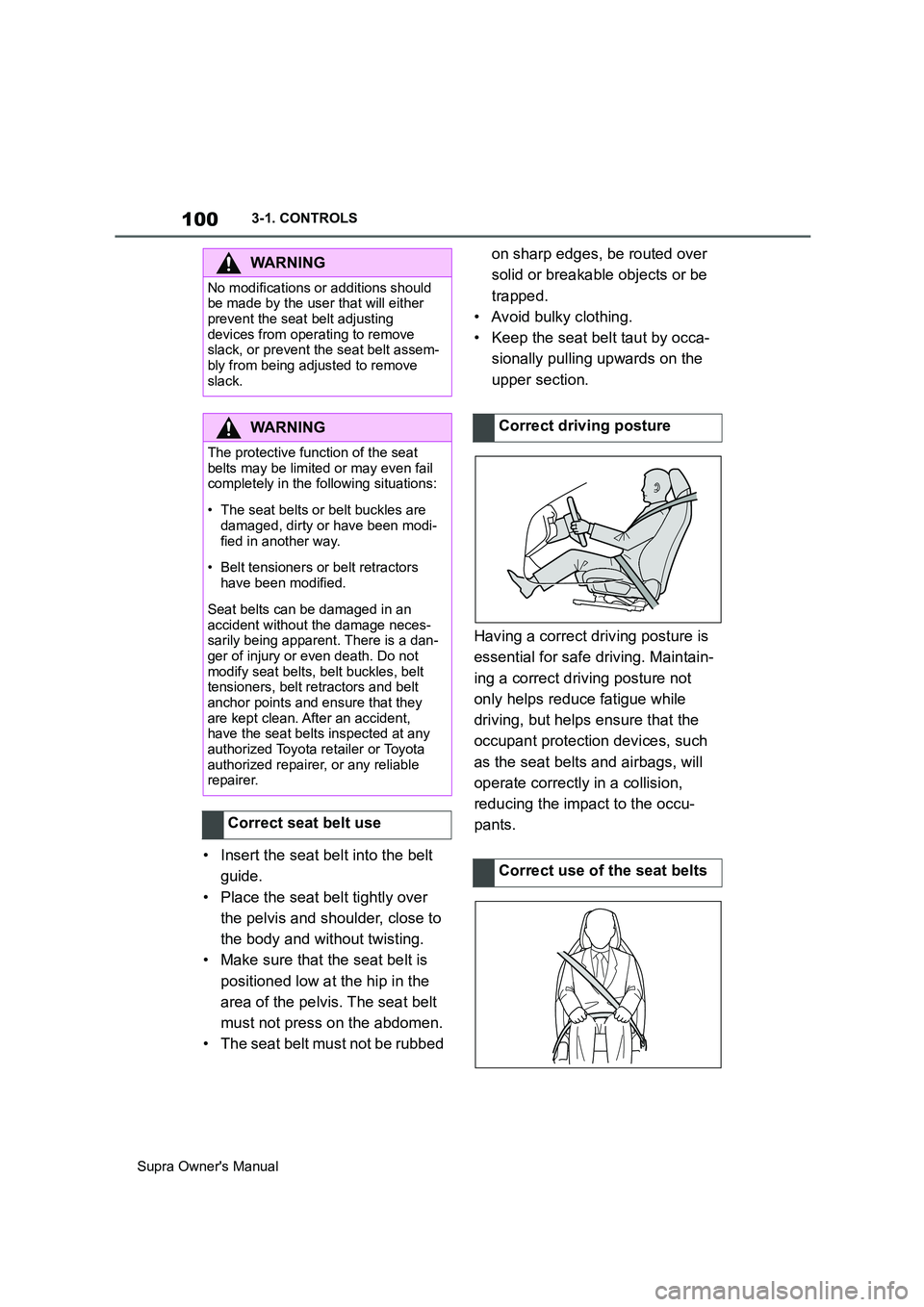
100
Supra Owner's Manual3-1. CONTROLS
• Insert the seat belt into the belt
guide.
• Place the seat belt tightly over
the pelvis and shoulder, close to
the body and without twisting.
• Make sure that the seat belt is
positioned low at the hip in the
area of the pelvis. The seat belt
must not press on the abdomen.
• The seat belt must not be rubbed on sharp edges, be routed over
solid or breakable objects or be
trapped.
• Avoid bulky clothing.
• Keep the seat belt taut by occa-
sionally pulling upwards on the
upper section.
Having a correct driving posture is
essential for safe driving. Maintain-
ing a correct driving posture not
only helps reduce fatigue while
driving, but helps ensure that the
occupant protection devices, such
as the seat belts and airbags, will
operate correctly in a collision,
reducing the impact to the occu-
pants.
WARNING
No modifications or additions should
be made by the user that will either
prevent the seat belt adjusting
devices from operating to remove
slack, or prevent the seat belt assem-
bly from being adjusted to remove
slack.
WARNING
The protective function of the seat
belts may be limited or may even fail
completely in the following situations:
• The seat belts or belt buckles are
damaged, dirty or have been modi-
fied in another way.
• Belt tensioners or belt retractors
have been modified.
Seat belts can be damaged in an
accident without the damage neces-
sarily being apparent. There is a dan-
ger of injury or even death. Do not
modify seat belts, belt buckles, belt
tensioners, belt retractors and belt
anchor points and ensure that they
are kept clean. After an accident,
have the seat belts inspected at any
authorized Toyota retailer or Toyota
authorized repairer, or any reliable
repairer.
Correct seat belt use
Correct driving posture
Correct use of the seat belts
Page 101 of 456

101
3
Supra Owner's Manual3-1. CONTROLS
CONTROLS
The most basic occupant protection
device is the seat belt. The airbags
are designed to supplement the
seat belts, not be used in place of
them. Wearing the seat belt cor-
rectly ensures that the occupants
are securely held in the seats and
helps prevent them from contacting
interior parts or being thrown from the vehicle in a collision. Therefore,
it is necessary for all occupants to
wear their seat belt. If a seat belt is
worn improperly, its effectiveness
as an occupant protection device
will be severely reduced. Pay atten-
tion to the following to ensure the
correct driving posture and use of
the seat belts.
Position the head restraint so that the center of it is at the same height
as the top of your ears
Make sure that the seat belt is not twisted
Adjust the seat so that your arms bend slightly at the elbow when grip-
ping the upper part of the steering wheel
Make sure that the seat belt is snug and not loose at any point
Position the lap belt as low as possible over the hips
Sit well back in the seat with the seatback uprightCorrect driving posture and use of the seat belts
A
B
C
D
E
F